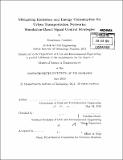Mitigating emissions and energy consumption for urban transportation networks : simulation-based signal control strategies
Author(s)
Nanduri, Kanchana
DownloadFull printable version (7.492Mb)
Other Contributors
Massachusetts Institute of Technology. Department of Civil and Environmental Engineering.
Advisor
Carolina Osorio.
Terms of use
Metadata
Show full item recordAbstract
Microscopic urban traffic simulators embed the most detailed traveler behavior and network supply models. They represent individual vehicles and can therefore account for vehicle-specific technologies. These simulators can be coupled with instantaneous energy consumption and emissions models to yield detailed network-wide estimates of energy consumption and pollutant emissions. Nonetheless, there is currently a lack of computationally efficient optimization techniques that enable the use of these complex integrated models to design sustainable transportation strategies. This thesis proposes a methodology that combines a stochastic microscopic traffic simulation model with an instantaneous vehicular fuel consumption model and consecutively, with an instantaneous vehicular emissions model. The combined models are embedded within a simulation-based optimization (SO) algorithm and used to address a signal control problem. First, a framework that combines travel time and fuel consumption in the objective is formulated followed by one combining travel time and various pollutant emissions. The proposed technique couples detailed, stochastic and computationally inefficient models, yet is an efficient optimization technique. Efficiency is achieved by combining simulated observations with analytical approximations of the objective functions. This methodology is applied to a network within the Swiss city of Lausanne. The proposed method identifies signal plans with improved travel time, fuel consumption and emissions metrics, and does so within a tight computational budget. It systematically outperforms traditional techniques, particularly when performance metrics with high variance, such as fuel consumption and emissions, are used. This method enables the use of disaggregate instantaneous vehicle-specific information to inform and improve traffic operations at the network-scale.
Description
Thesis (S.M. in Transportation)--Massachusetts Institute of Technology, Department of Civil and Environmental Engineering, 2013. Cataloged from PDF version of thesis. Includes bibliographical references (pages 81-85).
Date issued
2013Department
Massachusetts Institute of Technology. Department of Civil and Environmental EngineeringPublisher
Massachusetts Institute of Technology
Keywords
Civil and Environmental Engineering.